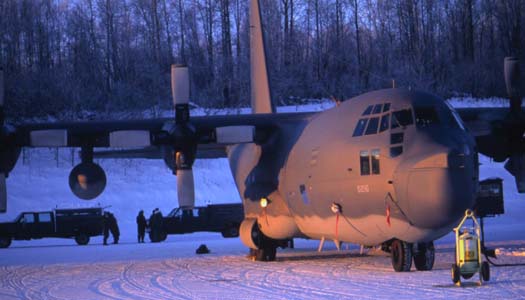MC-130P Combat Shadow

Mission
The MC-130P Combat Shadow flies clandestine or low visibility, low-level missions into politically sensitive or hostile territory to provide air refueling for special operations helicopters. The MC-130P primarily flies its single- or multi-ship missions at night to reduce detection and intercept by airborne threats.
Secondary mission capabilities include airdrop of small special operations teams, small bundles, and zodiac and combat rubber raiding craft; as well as night-vision goggle takeoffs and landings, tactical airborne radar approaches and in-flight refueling as a receiver.
Features
Special operations forces improvements are being made to the MC-130P. When modifications are complete in FY1999, all aircraft will feature improved navigation, communications, threat detection and countermeasures systems.
When fully modified, the Combat Shadow will have a fully integrated inertial navigation and global positioning system, and night-vision goggle-compatible interior and exterior lighting. It will also have a forward-looking infrared radar, missile and radar warning receivers, chaff and flare dispensers and night-vision goggle compatible heads-up display. In addition, it will have satellite and data burst communications, as well as in-flight refueling capability as a receiver.
The Combat Shadow can fly in the day against a reduced threat, however, crews normally fly night, low-level, air refueling and formation operations using night-vision goggles. To enhance the probability of mission success and survivability near populated areas, crews employ tactics that include incorporating no external lighting or communications, and avoiding radar and weapons detection.
Background
Originally designated as the HC-130 N/P, Air Force Special Operations aircraft were changed in February 1996 to align the aircraft with all other M-series special operations mission aircraft.
First flown in 1964, the aircraft has served many roles and missions. The aircraft was initially modified to conduct search and rescue missions, provide a command and control platform, ir refuel helicopters and carry supplemental fuel for extending range or air refueling.
MC-130P's have been a part of the special operations mission since the mid-1980s. They deployed to Saudi Arabia and Turkey in support of Desert Storm in 1990 to provide air refueling of special operations forces helicopters over friendly and hostile territory, as well as psychological operations and leaflet drops.
General Characteristics
Primary Function: Air refueling
for special operations forces helicopters
Builder: Lockheed Aircraft Corp.
Power Plant: Four Allison T56-A-15
turboprop engines
Thrust: 4,910 shaft horsepower
each engine
Length: 98 feet, 9 inches (30.09
meters)
Height: 38 feet, 6 inches (11.7
meters)
Maximum Takeoff Weight: 155,000
pounds (69,750 kilograms)
Wingspan: 132 feet, 7 inches (40.4
meters)
Speed: 289 miles per hour (464
kilometers per hour) at sea level
Ceiling: 33,000 feet (10,000 meters)
Range: Beyond 4,000 miles (3,478
nautical miles)
Crew: Four officers (pilot, co-pilot,
primary navigator, secondary navigator), and four enlisted (flight
engineer, communications systems operator and two loadmasters)
Unit Cost: $16.5 million (1992
dollars)
Date Deployed: 1986
Inventory: Active force, 23; ANG,
0; Reserve, 5
